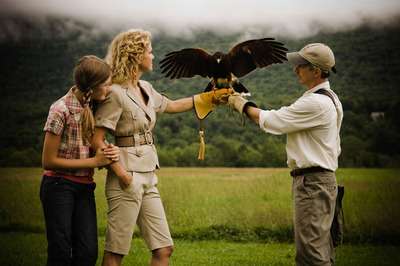- MENU
- HOME
- SEARCH
- WORLD
- MAIN
- AFRICA
- ASIA
- BALKANS
- EUROPE
- LATIN AMERICA
- MIDDLE EAST
- United Kingdom
- United States
- Argentina
- Australia
- Austria
- Benelux
- Brazil
- Canada
- China
- France
- Germany
- Greece
- Hungary
- India
- Indonesia
- Ireland
- Israel
- Italy
- Japan
- Korea
- Mexico
- New Zealand
- Pakistan
- Philippines
- Poland
- Russia
- South Africa
- Spain
- Taiwan
- Turkey
- USA
- BUSINESS
- WEALTH
- STOCKS
- TECH
- HEALTH
- LIFESTYLE
- ENTERTAINMENT
- SPORTS
- RSS
- iHaveNet.com: Travel
By Robin Cherry

Learn the art of falconry at The Equinox Resort
No need to settle for a gaggle of geese. Your family can visit a congregation of alligators, a coterie of prairie dogs and a cast of falcons at these wildlife locations around the United States.
GATOR AID
Wesley Moore rescues alligators (and introduces them to visitors) at Alligator Alley, an alligator preserve he owns in Summerdale, Ala., about 30 miles outside Mobile. The swampy preserve is home to more than 150 alligators that roam freely around their natural surroundings. Visitors can observe the alligators from a comfortable (and safe) distance by walking along the wooden piers that weave through the cypress swamps.
Moore leads the tours himself, and he's a riot. He names the female alligators after his friends' ex-girlfriends. As one of his laziest alligators, Fat Albert, lies on the side of the swamp sunning himself, Moore claims he taught him a trick. He puts up his hand and says, "Stay." The alligator doesn't move. "See," he chuckles.
If Captain Crunch conjures up the benign cereal mascot, meet Captain Crunch the alligator, a mammoth 800-pounder who holds the world record for the strongest holding bite ever recorded by an alligator -- a daunting 2,982 pounds. Moore says that the Captain's favorite foods are chicken, turtles, dogs, deer and slow swimmers. The alligators are fed at 11 a.m., 1 and 4 p.m.
Alligator Alley. 19950 Highway 71, Summerdale, Ala. Tel. 251-946-2483. Admission: $10 for adults, $8 for children 4 to 12, free for children 3 and under. Hours: 10 a.m. to 5 p.m. daily. www.gatoralleyfarm.com
LITTLE DOGS ON THE PRAIRIE
The prairie dogs at the
This Tucson museum is a triple threat -- combining a zoo, natural history museum and botanical garden. Most animals live in their regular habitats, spread across 21 acres of arid desert surrounded by the gentle peaks of the Tucson Mountains. Fortunately some live exhibits, like the rattlesnakes, are housed safely behind glass.
Keep your eyes open though, since you're apt to see a snake slither across your path or a warty Gila monster basking in the sun. Although the Gila monster is one of only two known venomous lizards in the world, visitors are unlikely to get bitten. In 1899, an Arizona doctor said he'd never been asked to treat a Gila monster bite; the creature is so sluggish, the only way to get bitten by one is to help it bite you.
FLY HUNTING
Falconry, the ancient art of hunting with birds of prey, is one of the few things in life that's both graceful and gruesome.
After an introduction, you're ready to put on a thick leather glove and learn to "fly the falcon," which means releasing it and then holding your arm out so it can return to your gloved fist.
Initially, you release the hawk to a perch in the middle of a clear meadow. When you and the hawk are in sync, the hawk feels like an extension of your arm. Once the initial fear wears off (and unless you are completely intrepid, there will be initial fear), you can't help but be awed by the grandeur of the hawk, its 6-foot wingspan and the exquisite grace with which it glides across the sky.
When you go on a hunt, you release the hawk, which circles overhead until your hawking dog flushes out prey. At that point, the hawk dives to the ground like a heat-seeking missile, snatching the small game in its death-trap talons (this is the gruesome part). The falconer runs to the site to distract the bird with a small bit of food, since game was originally caught so it could grace the dining room table of aristocrats. Today, you don't have to be a member of royalty to try falconry, but you do have to be over 12 years old.
The Equinox Resort, 3567 Main St., Route 7A, Manchester Village, Vt. Tel. 802-362-4780. Falconry lessons range from $70 to $345 for resort guests. www.equinoxresort.com.
Wildlife Activities for Families
© Travel Muse Distributed by Tribune Media Services, Inc.
AUTOS | HOBBIES | EDUCATION | FAMILY | FASHION | FOOD & RECIPES | HOME DECOR | RELATIONSHIPS | PARENTING | PETS | TRAVEL | WOMEN
Vacation Travel - Where the Wild Things Are